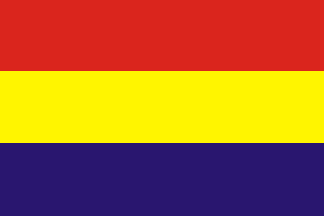![[Provincial flag of Overijssel]](../images/n/nl-ov.gif) image by Mark Sensen, 4 May 1999
image by Mark Sensen, 4 May 1999
adopted 21 Jul 1948

Last modified: 2014-06-28 by andrew weeks
Keywords: overijssel |
Links: FOTW homepage |
search |
disclaimer and copyright |
write us |
mirrors
![[Provincial flag of Overijssel]](../images/n/nl-ov.gif) image by Mark Sensen, 4 May 1999
image by Mark Sensen, 4 May 1999
adopted 21 Jul 1948
Flag: H:L = 10:17; "Five equal stripes red-yellow-blue-yellow-red, the
blue stripe being wavy".
Adopted by Decision of the Provincial States of Overijssel, 21 July
1948, nr. 14
Explanation: In the Middle Ages Overijssel and Drenthe belonged to the
Diocese of Utrecht, the "Sticht", and, being the outer parts, they were
called "Oversticht". When Emperor Charles V gained these lands from Utrecht,
he called the lands around the river IJssel, Salland and Twenthe "Overijssel".
In 1579 Overijssel gained its own arms: the Dutch red lion with a blue
fess wavy, symbolizing the river IJssel, after which the province has been
named. The modern flag is a simple and wonderful derivation from the arms.
Source: "The Dutch provinces: Their arms, their flags, their pennants,
their banners", by Hans van Heijningen, 27 March 1993, in: Vexillavaria,
occasional paper of Vexilla Nostra.
According to Kl. Sierksma, Nederlands vlaggenboek (1962) Overijssel
did not have a historic legacy regarding its flag. It always used the banner
of the Bishop of Utrecht. When it came to adopting a new flag some suggested
using the "Twentsche Ros", the old Saxon white horse on red, but this was
rejected, because it didn't represent Salland and the Western part of the
province. Others suggested putting the lion from the arms on the flag;
that was rejected for financial reasons.
Jarig Bakker, 14 Sep 2009
Previous
flag of Overijssel?
Jaume Olle, 12 Sep 2009
The flag reported by Jaume seems to be a modern table flag - I have
no idea who used it. A quick Google-search delivered no hits.
Jarig Bakker, 14 Sep 2009
.gif) International Civic Arms : http://www.ngw.nl/
International Civic Arms : http://www.ngw.nl/
"Or, a fess wavy azure, over all a lion rampant gules, armed and langued
azure. The shield is crested by a coronet of four pearls between five leaves
or. Supporters: two lions rampant proper, langued gules."
 image by Jarig Bakker, 26 January 2001
image by Jarig Bakker, 26 January 2001
In 1938 Queen Wilhelmina had reigned the Netherlands for 40 years. On
that occasion a lot of municipalities paraded in front of HM with their
flags, which consisted of the provincial flag with the municipal Coat of Arms in
the canton (or something...). Those municipal flags can only be considered
as 'curiosities', while the status of the provincial flags is not quite
clear.
Jarig Bakker, 26 January 2001